Dr. Fatima Zarinni
Adjunct Faculty and Research Scientist, Computer Science Dept., NYU (Courant)
An In-depth Study of HTTPS, HTTP/2 and QUIC for Popular Mobile Applications (Currently Ongoing)

Mobile devices are increasingly being used as a means for accessing web content, over both cellular and Wifi networks.
The defacto transport layer protocol used until today, by popular web-based applications, such as, web browsers,
video streaming apps and file download/upload apps, is TCP.
However, recent work shows that, even application-level optimizations, such as, HTTP/2 does not always improve performance when
used on top of TCP.
To further improve performance, Google has developed the QUIC protocol, that goes against convention and serves web content on top
of UDP instead of TCP. In addition to implementing a Congestion Control scheme, QUIC also has several other striking new
features.
However the true benefits achieved with all these optimizations is very vague, and not well-understood.
In this project, we conduct the first extensive and systematic measurement study to understand, characterize and compare the performance
attained for popular mobile applications, with HTTPS, HTTP/2, QUIC and other state-of-the-art lower-layer protocols.
We study the Quality of Experience (QoE) of 3 popular mobile applications, namely, web browsing, video streaming and
bulk transfers.
We conduct measurements on a wide range of network parameters, and for different webpage, video
and file characteristics. We also conduct cross-layer analysis to capture and understand the complex interactions between
the application layer, congestion control and packet-loss recovery mechanisms, and the lower layers, that
impact application performance.
Using Statistical Analysis and Machine-learning techniques, we will create models that will help in factor and data analysis and
will give a wholistic view of when and why which protcol performs better than the other.
Based on the insights attained, we plan to develop QUIC+, to further improve performance for mobile web-based applications.
Exploring QUIC protocol for Multipath and a Comparison with MP-TCP
(Currently Ongoing)

In today's smartphones and tablets, communication takes place with either the WiFi interface, or the mobile interface (4G/LTE), but, not with both at the same time. There is a shift happening in this paradigm, where in the near future, both interfaces can be used simultaneously for communication. The QUIC protocol's Connection ID implementation, makes this new form of communication possible and seamless to the user. In this project, we will conduct an in-depth measaurement study of the impact of QUIC protocol over multi-path, on the end-user's Quality of Experience (QoE), for popular mobile applications, such as web browsing, video, VoIP and bulk transfer. We will also compare QUIC's performance against MP-TCP and other state-of-the-art protocols, as well as, single-path QUIC and single-path HTTP/2. We will also analyze cross-layer interactions, to understand the reason behind the observed QoE with each of the protocols.
Understanding and Improving Energy-efficiency in IEEE 802.11ac and Future WiFi Systems
(Currently Ongoing)
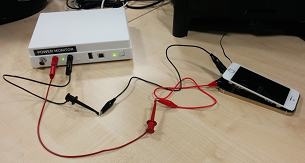
The new generation of WiFi networks (802.11ac) allows for faster link layer data rates in 3 ways: (1) by using multiple antennae technology (MIMO), (2) higher modulation rates and (3) wider channel widths (20 MHz, 40 MHz, 80 MHz and 160 MHz). However, understanding the power consumption of the new Wi-Fi technology in these settings, is yet to be explored fully. In this work, we implement a system for studying the power consumed by the phones under 4 types of internet traffic: bulk download, web browsing, video streaming, VoIP applications such as Pandora and Spotify. We conduct an extensive measurement study under different interference scenarios. Based on insights attained, we aim to design new energy-efficient protocols specific to next-generation WiFi networks.
A First Look at Performance in Mobile Virtual Network Operators (MVNOs)

This project focuses on an emerging and important, yet unexplored, area in Cellular Networks, Mobile Virtual Network Operators or MVNOs, that operate on top of existing cellular infrastructures. While MVNOs have shown significant growth in the US and elsewhere in the past two years and have been successful in attracting customers, there is no prior systematic study to understand performance in such networks. We present the first systematic measurement study to shed light on this emerging phenomenon. We develop our own measurement tools and testbeds, with actual smartphones, and we study in detail the performance of 3 key applications: web access, video streaming and voice, in 2 popular MVNO families (a total of 8 carriers) in the US. Interestingly, we find that some MVNOs do indeed exhibit significant performance degradation and that there are key differences between the two MVNO families. Our measurements, analysis and new insights are beneficial to not only end-users, but also to MVNOs, underlying carriers and application developers.
btFICA MAC Protocol for High Data Rate WLANs
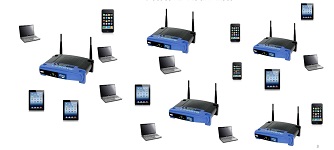
In this project we develop a new MAC protocol for improving network throughput and hence, channel utilization in wireless LANs that can support very high PHY layer data rates (> 1Gbps). We call our new MAC protocol Busy Tone Assisted Fine-Grained Channel Access (btFICA). btFICA is based upon the framework of a prominent state-of-the-art PHY/MAC scheme for high data rate WLANs, called Fine-Grained Channel Access (FICA). While the rationale behind the FICA scheme appears effective for enhancing channel utilization in high data rate WLANs, a recent study shows that problems, such as deafness, muteness and a form of hidden terminal problem, can easily arise with the FICA MAC protocol. These problems can degrade the network performance, if left unaddressed. This motivates us to develop our btFICA MAC protocol that uses an additional busy tone antenna. btFICA comprehensively solves all of the three problems faced by the FICA MAC protocol, while maintaining the beneficial aspects of the original FICA scheme. Finally, we show via extensive simulations, that btFICA significantly outperforms the original FICA scheme and 802.11 DCF, in different network topologies and traffic scenarios, in terms of channel utilization, per-user-throughput and fairness.
Understanding the FICA MAC Protocol in High Data Rate WLANs
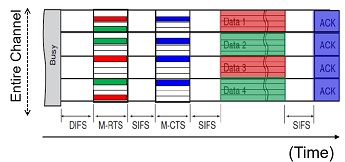
Recently wireless radios and hardware technologies have been developed that allow operation on very wide channels and that can support very high physical layer data rates (1Gbps and up). However, it is proven that the conventional 802.11 CSMA/CA MAC protocol causes a drastic under-utilization of such high-speed channels. In order to improve channel utilization, a new scheme, called, Fine-Grained Channel Access (FICA), has been recently put forward. While the FICA approach appears more promising than the other proposed schemes for high data rate WLANs, it has not been studied extensively before. Hence, in this paper, we focus on the FICA MAC protocol, and we study this protocol thoroughly in different traffic scenarios and network topologies. We identify, for the first time, some of the serious problems that can arise with the FICA MAC protocol. We call these problems deafness, muteness and a form of hidden terminal problem. We quantify the impact of these problems on the performance of FICA via extensive simulations. Our results show that under some typical scenarios, FICA can perform even worse than the conventional 802.11 DCF, in terms of channel utilization, per-user-throughput or fairness. The insights obtained in this paper motivates the need for addressing FICA's problems and paves the path for future development of better new MAC protocols for high data rate WLANs.
Ez-Channel: A distributed MAC protocol for efficient channelization in wireless networks
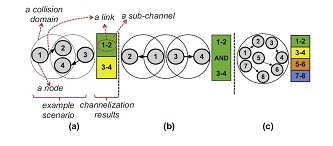
There is a significant interest in new wireless multiple access protocols that adaptively split a wide frequency channel into multiple sub-channels—perhaps of varying widths—and assign these sub-channels to competing transmissions. Existing protocols suffer from various limitations such as considerable protocol overhead, dependence on a centralized controller, and use of fixed-size channels. We introduce Ez-Channel, a novel MAC protocol that parsimoniously utilizes the OFDM sub-carriers to perform channelization and assignment of sub-channels to competing links. In addition to circumventing hidden and exposed terminal problems, Ez-Channel adapts channel assignments to the network topology. To eliminate the need for a centralized controller and to avoid an overwhelming amount of information exchange, the protocol uses a randomization technique enabling provably effi- cient localized decision making. Our extensive analytical and simulation studies show that Ez-Channel yields significant throughput improvements as compared to the state-of-theart protocols.
Adaptive Spectrum Distribution in Centralized WLANs with Multiple Collision Domains
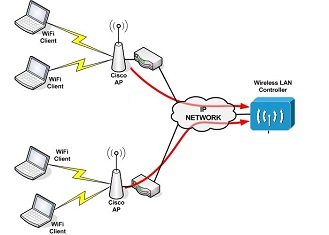
The IEEE 802.11 standard statically channelizes the wide spectrum into smaller channels of equal width, and classically, each access point is assigned one of these channels to operate on. While an intelligent channel assignment for interfering APs can provide better network performance than just any arbitrary channel assignment, still recent work shows that even far better performance can be achieved if the fixed 802.11 channels are not used and instead the channel width and central frequency for each AP is adapted, based upon the traffic load at each AP in the network. However, the existing work for dynamic distribution of spectrum amongst APs, provides non-overlapping channels to interfering APs, which can cause loss of spectral reuse opportunities. In this paper, we tackle the problem of adaptive spectrum distribution from a theoretic and algorithmic perspective. We propose a new dynamic spectrum distribution technique in infrastructured wireless LANs, that exploits spectrum reuse opportunities and allows overlap between channels provided to interfering APs. Our technique achieves two goals: 1) max-min fairness amongst flows in the network and 2) high network throughput. Finally, we evaluate the performance of our technique, via simulations, and present its superiority when compared to single-channel 802.11-like DCF, classic fixed channelization and the state-of-the-art dynamic spectrum distribution technique for WLANs.
Mobile Applications for Informal Economies

The proliferation of mobile phones across the world, to people of all statures, has provided platform to bring computing resources to the masses. In this project we develop three mobile phone applications designed to aid the businesses and people of informal economies in developing countries. The goal of the applications is to assist in the growth of the economy through financial education and awareness and to assist and further the literacy. Each application is motivated and inspired by the needs of the women at the Saint-Louis Women’s Business Center Incubator in Senegal, Africa. When desiging and developing our applications we face several challenges specific to the region, such as, proliferation of non-android, non-touch phones with limited display screens, and the need for careful design of the GUI to make our applications easy to use. We use the J2ME programming language, and in our publication, we describe the motivations, challenges, application design and operation, and the lessons learned throughout a year of development.
High Data Rate Wireless Networks - A Study of MAC Challenges and Comparison of Channelization Solutions against Other Potential MAC Solutions.

High data rate wireless networks (1 Gbps and up) are in
the horizon and several standards are in the works. However,
the task of designing multiple access protocols for such
networks is fraught with new challenges as the bandwidth
independent overheads dominate. We show that even when
such overheads are kept at a minimum, the performance of
multiple access protocols can be very poor. However, performance
can be improved significantly by splitting the given
bandwidth into multiple channels and running the multiple
access protocol independently on these channels. Taking an
802.11-like CSMA/CA (DCF) protocol as an example we
show via a modeling exercise how such channelization can
improve performance and why it needs to be adaptive to
traffic demand. We develop an Adaptive Multichannel (AMC)
protocol and study its performance via simulations.
In addition, we also investigate two other potential MAC solutions, namely,
(a) Single-channel Extended-Reservation Scheme and (b) the Pipelining schemes. We show that the Extended-Reservation
protocol performs better than the single channel 802.11-like
DCF protocol and is comparable to adaptive multichannel
protocol (AMC), but it suffers from an inherent unfairness
issue due to which many nodes starve for channel access. The
multichannel protocol, on the other hand, is devoid of such
fairness problems. Similarly, we show that although the Pipelining protocol is
designed to reduce the contention overheads, it performs poorly in High data rate
settings, even when it is optimized, in terms of both network throughput and fairness.
Finally, we develop a ‘scaled down’ prototype implementation
using the USRP/GNURadio platform to demonstrate that
adaptive channelization can be practical using appropriate programmable
radio hardware and has tremendous performance
potential. Taking our modeling, simulation and experimental
results together, our work shows that a throughput gain of a
factor of 2 is not unrealistic.
Twinkle: A Novel AP-discovery Scheme for Whitespace Networks

The number of channels that can potentially be used for whitespace communication by secondary APs is many. In existing schemes, clients have to scan all the channels in search of secondary APs and to avoid interference with primary APs. This causes significant wastage of energy and large connect times. To address this problem, we designed and implemented a fast, accurate and energy-efficient technique for both discovering secondary-APs in a whitespace networks, and avoiding interference with many primary users. Instead of scanning the entire spectrum for beacons, our technique listens for tones. We show via simulations that Twinkle can discover secondary APs significantly faster than state-of-the-art techniques, while avoiding interference with primary APs.
Implementation of MAC/PHY Schemes with GnuRadio/USRP
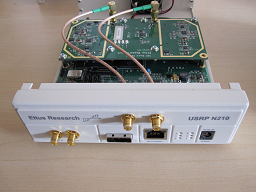
We successfully established communication between USRP/GNURadio and TelosB Motes. We were capable of sending and receiving Zigbee packets on both the USRP and TelosB Mote nodes. In a second project, we used three GNURadio/USRP nodes – one to act as a receiver, and the other two to act as senders. We successfully set up one receiver node to listen on multiple non-overlapping channels simultaneously, by having different software paths at the receiver to decode each channel. We then allowed the two senders to simultaneously transmit on two different channels. In a third project, using two USRP nodes- one acting as a receiver and the other as a transmitter, we could successfully transmit and receive multiple tones simultaneously on different subcarriers. Our testbed was then used for different experiments in the lab.
© Copyright 2016 - present by Fatima Zarinni, New York University, NYU (Courant)
© Copyright 2009 - 2016 by Fatima Zarinni, Stony Brook University